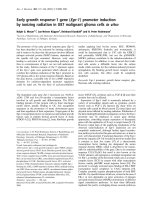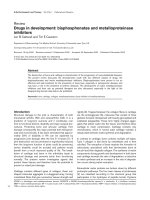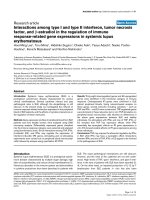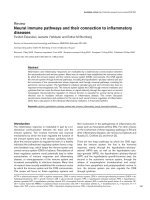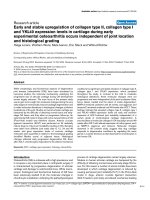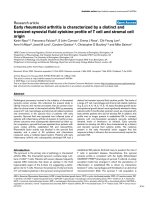Báo cáo y học: " Early immune development, atopy and asthma" ppt
Bạn đang xem bản rút gọn của tài liệu. Xem và tải ngay bản đầy đủ của tài liệu tại đây (47.83 KB, 4 trang )
commentary review
reports
research article
1
CBMC = cord blood mononuclear cell; IFN = interferon; IL = interleukin; NF = nuclear factor; RSV = respiratory syncytial virus; Th = T-helper cell;
TNF-α = tumor necrosis factor-α.
Available online />Introduction
Recent evidence suggests that the initiation of atopy and
asthma may occur early in life, even prenatally. To identify
environmental and genetic risk factors, several epidemio-
logical studies are underway. In parallel, studies are inves-
tigating the mechanisms of early onset of atopy and
asthma. At the American Thoracic Society meeting 2001
in San Francisco, multiple reports addressed epidemiolog-
ical and immunological factors and their influence on the
early immune system and the development of atopy and
asthma. While not comprehensive, this report provides a
brief summary of selected presentations on these topics,
focusing on human studies.
Review
Risk and protective factors
Environmental factors, whether indoor or outdoor, are
under investigation to determine their role in the initiation
of atopy and asthma. Whether certain factors are protec-
tive or are, in fact, risk factors forms the basis of the
studies described below.
Breast-feeding
The protective effect of breast-feeding against the devel-
opment of allergy and asthma remains controversial. Dell
et al (Hospital for Sick Children, Toronto, Canada) com-
pared two groups of Canadian children less than two
Meeting report
Early immune development, atopy and asthma: insights from ATS
2001, May 18–23, San Francisco
Christian H Schroeter and Patricia W Finn
Pulmonary Division, Brigham and Women’s Hospital, Boston, Massachusetts, USA
Correspondence: Patricia W Finn, Pulmonary Division, Brigham and Women’s Hospital, 75 Francis Street, Boston, MA 02115, USA.
Tel: +1 617 278 0704; fax: +1 617 264 6341; e-mail:
Abstract
There is rising evidence that the initiation of atopy and asthma may occur in early life or even during
fetal life. At the American Thoracic Society meeting 2001 in San Francisco, multiple reports addressed
epidemiological and immunological factors and their influence on the early immune system, as well as
the development of atopy and asthma. Epidemiologic studies presented at the meeting suggest a
protective effect of farming and pet exposure. Early-life exposure to endotoxin, a cell wall component of
Gram-negative bacteria which can be found in high levels in the presence of pets, may have a
protective effect. Investigations of the mechanism of the early immune system indicate that
mononuclear cord blood cells have the ability to mount a lymphoproliferative response to mitogens and
allergens. Reports suggest, however, that the validity of Th1/Th2 paradigm may need to be scrutinized
in early human immune responses, particularly regarding the assumption that the neonate immune
system is Th2 skewed. The prospective longitudinal follow-up of these studies is promising to give
further insight into risk and protective factors in the development in atopy and asthma.
Keywords: asthma, children, endotoxin, immune response, neonatal
Received: 11 June 2001
Accepted: 13 June 2001
Published: 26 June 2001
Respir Res 2001, 2:E002
© 2001 BioMed Central Ltd
(Print ISSN 1465-9921; Online ISSN 1465-993X)
2
Respiratory Research Vol 2 No 5 Schroeter and Finn
years of age for the onset of asthma and wheeze. The
prevalence of asthma increased over time, while the preva-
lence of wheeze remained the same. Concomitant with an
increase in the prevalence of breast-feeding, both prenatal
and postnatal maternal smoking decreased significantly. A
protective effect of breast-feeding against asthma as well as
against wheeze was shown with increasing duration of
breast-feeding. While this study suggests a short-term
effect of breast-feeding on the development of atopy and
asthma, the long-term effects will need to be addressed [1].
Pets and endotoxin exposure
To examine the relationship between pets, vermin and
endotoxin in house dust, Heinrich et al (GSF Neuherberg,
Munich, Germany) investigated the homes of German chil-
dren aged 5–10 years. Endotoxin concentrations in dust
samples were significantly increased with the presence of
dog, cat and cockroach. The authors conclude that having
dogs or cats in the home is consistent with higher expo-
sure to endotoxin. Also, based on previous reports of pro-
tective effects of cats or dogs on the development of
atopy, endotoxin exposure may contribute to a lower risk
of atopy in later life [2].
Exposure to pets in the first year of life and the impact on
atopy and lung function was investigated by Ownby et al
(Henry Ford Hospital, Detroit, MI, USA). Interestingly,
exposure to two or more animals (cats or dogs) was asso-
ciated with a significantly lower prevalence of any positive
skin test and any allergen-specific IgE at six to seven years
of age. For boys only, exposure to two or more pets was
associated with a lower total serum IgE, prevalence of
methacholine responsiveness and better lung function.
This also suggests a role for endotoxin as a protector in
atopy and, particularly in boys, leads to an improvement in
lung function [3].
Litonjua et al (Channing Laboratory, Boston, MA, USA)
presented results from a longitudinal study regarding
association between house dust endotoxin levels and
wheeze in young children. In their cohort the exposure to
higher levels of endotoxin early in life is associated with
increased wheezing episodes in children less than six
years old. Their model, however, predicted a decreasing
risk over time, concluding that endotoxin exposure may be
protective against further wheezing episodes in children
older than six years. This prediction supports the hypothe-
sis of a protective effect of endotoxin, including dogs or
cats as a reservoir of endotoxin [4].
Farming exposure
A cross-sectional study performed in European rural com-
munities investigated the effect of farming. Braun-Fahrlan-
der et al (Institute of Social Medicine, University of Basel,
Switzerland) reported that the timing and the duration of
exposure to stables, and consumption of farm milk during
the first year of life, are essential for a strong protective
effect against the development of asthma, hay fever and
atopic sensitization. While maternal exposure has an inde-
pendent effect, the role of exposure during pregnancy as
well as the effect of breast-feeding in this study has not
been evaluated. The authors speculate that farming expo-
sure may be a surrogate marker for other types of
microbacterial exposure like endotoxin. As endotoxin levels
are increased in stables this report suggests that endo-
toxin exposure is a protective factor against the later onset
of atopic diseases [5].
Timing of sensitization in early childhood
Exploring patterns of atopic sensitization in association
with childhood asthma, Illi et al (Dr von Haunersches
Kinderspital, Munich, Germany) presented results from the
German Multicenter Allergy Study. The investigators found
that an early sensitization to food allergens before the age
of two is only associated with asthma at the age of seven
when a subsequent sensitization to inhalant allergens
occurs. Also, a positive parental history of asthma or allergy
must be present. The authors conclude that an underlying
factor pertaining to asthma and maternal transmission may
determine both a certain pattern of sensitization and the
later expression of an asthmatic phenotype [6].
Cord blood response profiles
Recent studies addressing the onset of atopy and/or
asthma have also focused upon the developing immune
system. Specifically, these studies have used the
approach of examining functional immune responses in
relationship to the later development of atopy and asthma.
In the Th1/Th2 paradigm these diseases are thought to be
Th2 skewed. Furthermore, pregnancy and the neonatal
immune response are described as Th2-dominated. Con-
flicting data for the Th2 paradigm in the neonatal immune
response will be presented in the following reports. Addi-
tionally one study investigated the expression of pheno-
types combined with functional studies in cord blood
mononuclear cells (CBMCs).
Cytokine profile in cord blood mononuclear cells and risk for
viral infections
The association of cord blood cytokine response profiles
after mitogen stimulation and infection with respiratory
syncytial virus (RSV) in the first year of life was examined
by Meyer et al (University of Wisconsin, Madison, WI,
USA). Children who developed viral infection in the first
year of life had a significantly reduced interferon (IFN)-γ/
IL-13 ratio. RSV-positive respiratory infections showed pri-
marily a relationship to IL-13 responses. A significant rela-
tionship between the absolute level of IL-13 and the
incidence of RSV-associated lower respiratory tract infec-
tions was found. The authors conclude that a diminished
mitogen-induced CBMC production of IL-13 may charac-
terize infants who are at risk of developing RSV-associ-
commentary review
reports
research article
3
ated lower respiratory tract infections during infancy. This
cohort will be of special interest when examining the longi-
tudinal follow-up of RSV infections in early life as it will
provide a predictor of wheezing and development of atopy
in later life [7].
Interleukin-12 production in cord blood mononuclear cells
IL-12, as an inhibitory cytokine for Th2 responses and a
promoter for Th1 development, can increase cytotoxic
T-lymphocyte responses and induce IFN-γ synthesis. To
investigate IL-12 synthesis in humans, Upham et al (Insti-
tute for Child Health Research, Perth, Australia) examined
IL-12 p70 production by CBMCs, five-year-old children
and adults following stimulation with lipopolysaccharide
and IFN-γ. They found a markedly reduced production of
IL-12 p70 in CBMCs and peripheral blood mononuclear
cells (PBMCs) from five-year-old children compared to
PBMCs from adults. In contrast, cord-blood-derived den-
dritic cells synthesized comparably high levels of IL-12 [8].
Interleukin-4 and IFN-
γ
production in cord blood mononuclear
cells
The production of IL-4 and IFN-γ in cord blood and infant
cells was investigated by Halonen et al (University of
Arizona, Tucson, AZ, USA). IL-4 and IFN-γ levels from
CBMCs and mononuclear cells from infants aged two
months and PBMCs from their mothers were investigated.
The report showed a substantial reduction in the level of
both cytokines in the infants compared to their mothers.
Furthermore, IFN-γ production was directly related to IL-4
production in all samples. The authors conclude that these
data indicate a remarkable tendency to maintain an IL-
4/IFN-γ balance in infancy [9].
Interleukin-5 production in cord blood mononuclear cells
Miller et al (Columbia-Presbyterian Medical Center, New
York, USA) compared mitogen-induced and allergen-
induced proliferation and cytokine production of CBMCs
in a cohort of Dominican and African Americans in New
York. CBMCs had a significantly higher production of IL-5
in the presence of mitogen, cockroach, house dust mite or
mouse antigen than in the absence of these. In response
to dust mite, however, IL-5 and IFN-γ production increased
in specific association with T cell proliferation. The cohort
will be followed to investigate clinical correlation [10].
Phenotypic and functional characteristics of cord blood
mononuclear cells
Looking at phenotype expression in CBMCs, Contreras et
al (Brigham and Women’s Hospital, Boston, MA, USA)
reported up-regulation of CD4 after mitogen stimulation.
CD45RA (memory cell marker) and CD45RO (naïve
marker) were significantly up-regulated. Also, several
samples showed a lymphoproliferative response to aller-
gens such as cockroach (Bla g2) and house dust mite
(Der f1) and produced IL-10, IL-13, IFN-γ and tumor
necrosis factor-α (TNF-α). This report indicates that
CBMCs can develop a mitogen-induced mature pheno-
type and they have the ability to respond to common
aeroallergens with the production of both Th1 and Th2
cytokines [11].
Activation of transcription factors in cord blood mononuclear
cells
Our own study (Schroeter et al, Brigham and Women’s
Hospital, Boston, MA, USA) investigated CMBCs for pro-
liferative responses, cytokine production and regulation of
the transcription factor NF-κB, a pivotal transcription
factor in the inflammatory response. Comparing protein-
DNA binding of nuclear extracts derived from mitogen-
induced CBMCs with nuclear extracts from uninduced
CBMCs, we found differential regulation of NF-κB activa-
tion. Furthermore, there was no significant difference
between samples with up-regulation of NF-κB and those
with down-regulation of IL-5, IL-13, TNF-α and IFN-γ. Both
cytokine patterns, Th1 (IFN-γ and TNF-α) and Th2 (IL-5
and IL-13) were present. All samples were able to mount a
mitogen-induced proliferative response. These data
support the conclusion that CBMCs have a functionally
intact immune response, which might be more complex
than the Th1/Th2 paradigm. This cohort will provide the
potential to correlate clinical data and immunological find-
ings in a longitudinal follow-up [12].
Conclusion
Different approaches, epidemiological as well as immuno-
logical, have contributed further insights into the develop-
ment of atopy and asthma. The recent presentations at the
ATS meeting 2001 showed the important role of the early
years for the development of the immune system and for
the onset of atopy or asthma. Environment may play an
important role in the priming of the immune system.
Special interest was focused on exposure to endotoxin,
which seems to exert both a protective effect as well as an
increased risk for enhancing immune responses. The valid-
ity of the Th1/Th2 paradigm needs to be scrutinized in
early human immune responses, particularly human cord
blood immune responses shown in this review. Prospec-
tive follow-ups of these cohorts may provide important
information for identifying and confirming known and novel
biomarkers as risk or protective factors for developing
atopy and asthma.
Acknowledgements
This work is supported by NIH AI-45007 (PWF) and DFG Schr 711/1-1
(CHS).
References
1. Dell SD, Ip D, To T: Breastfeeding and asthma in young Cana-
dian children: Trends in time. Am J Respir Crit Care Med 2001,
163:A886.
2. Heinrich J, Gehring U, Douwes J, Koch A, Fahlbusch B, Bischof
W, Wichmann HE: Pets and vermin are associated with high
endotoxin levels in house dust. Am J Respir Crit Care Med
2001, 163:A844.
Available online />4
3. Ownby DR, Johnson CC, Peterson EL: Exposure to cats and
dogs during the first year of life reduces atopy and improves
lung function. Am J Respir Crit Care Med 2001, 163:A722.
4. Litonjua AA, Milton D, Celedon JC, Ryan L, Sredl D, Weiss ST,
Gold DR: Longitudinal association between house dust endo-
toxin levels and wheeze in young children. Am J Respir Crit
Care Med 2001, 163:A845.
5. Braun-Fahrlander C, Eder W, Schreuer M, Riedler J, Carr D,
Maisch S, Waser M, Schierl R, Nowak D, von Mutius E: Exposure
to farming environment during the first year of life protects
against the development of asthma and allergy. Am J Respir
Crit Care Med 2001, 163:A157.
6. Illi S, von Mutius E, Lau S, Niggemann B, Nickel R, Wahn U:
Pattern of atopic sensitization associated with asthma in
childhood. Am J Respir Crit Care Med 2001, 163:A39.
7. Meyer PA, Roberg KA, Anklam KS, Shult P, Kirk C, DaSilva D,
Zeng L, Gern JE, Lemanske RF: Association of neonatal cord
blood Th1/Th2 cytokine response profiles with respiratory
syncytial virus infection in the first year of life. Am J Respir Crit
Care Med 2001, 163:A972.
8. Upham JW, Lee P, Holt B, Holt P: Mononuclear cells from both
neonates and children exhibit reduced capacity to synthesize
IL12. Am J Respir Crit Care Med 2001, 163:A753.
9. Halonen MJ, Stern DA, Lohman IC, Tebow GL, Martinez FD,
Wright AL: Direct relationship of the capacity to produce IL-4
and IFN-
γγ
in infants. Am J Respir Crit Care Med 2001, 163:A54.
10. Miller RL, Biedermann SA, Bell CA, Halasz G, Jerzynska J, Whyatt
RM, Perera FP, Ford JG: Cord blood proliferation and cytokine
production in response to indoor allergens in an inner-city
cohort. Am J Respir Crit Care Med 2001, 163:A868.
11. Contreras JP, Schroeter CH, Donovan C, Sonna LA, Norwick E,
Weiss S, Gold D, Perkins DL, Finn PW: Phenotypic and func-
tional characteristics of neonatal immune response to
mitogen and allergens. Am J Respir Crit Care Med 2001,
163:A749.
12. Schroeter CH, Contreras JP, Gold D, Weiss S, Norwick E,
Perkins DL, Finn PW: Early immune signals: Regulation of
NF-
κκ
B in human cord blood mononuclear cells. Am J Respir
Crit Care Med 2001, 163:A577.
Respiratory Research Vol 2 No 5 Schroeter and Finn
